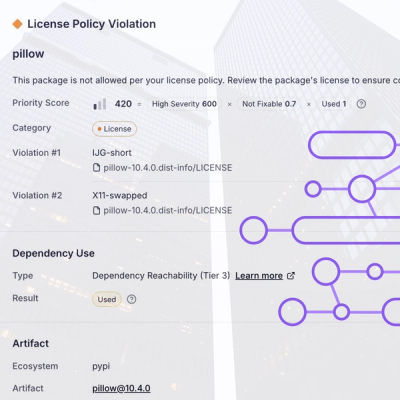
Research
/Security News
Critical Vulnerability in NestJS Devtools: Localhost RCE via Sandbox Escape
A flawed sandbox in @nestjs/devtools-integration lets attackers run code on your machine via CSRF, leading to full Remote Code Execution (RCE).
angularjs-nouislider
Advanced tools
An AngularJS wrapper for the noUiSlider range slider with minimal overhead.
An AngularJS wrapper for the noUiSlider range slider with minimal overhead. The module is ~1kb when minimized and gzipped.
Two demos can be found here. One demo without the use of ngModel and one with the use of ngModel.
angularjs-nouislider does not include Angular nor does it include noUiSlider, therefore Angular and noUiSlider need to be included or installed separately.
Make sure you have the angular and nouislider NPM packages installed, and then you can install the angularjs-nouislider NPM package with
npm install angularjs-nouislider --save
Make sure you have the angular and nouislider Bower packages installed, and then you can install the angularjs-nouislider Bower package with
bower install angularjs-nouislider --save
Make sure you have the angular and nouislider Yarn packages installed, and then you can install the angularjs-nouislider Yarn package with
yarn add angularjs-nouislider
You can download the angularjs-nouislider.js and angularjs-nouislider.min.js source in the dist folder and import them using a <script> tag. angularjs-nouislider needs to be imported after Angular and noUiSlider are imported.
<script src="path/to/angular.min.js"></script>
<script src="path/to/nouislider.min.js"></script>
<script src="path/to/angularjs-nouislider.min.js"></script>
It is recommended that you also download the angularjs-nouislider.js.map and / or angularjs-nouislider.min.js.map files and put them in the same folder to enable sourcemaps for easy debugging.
The module is wrapped using a Universal Module Definition (UMD). This way it can be included multiple ways:
import angular from 'angular'; // This is optional since angularjs-nouislider imports Angular itself
import noUiSliderModule from 'angularjs-nouislider'; // We export the module name for you
angular.module('myModule', [noUiSliderModule]);
var angular = require('angular'); // This is optional since angularjs-nouislider imports Angular itself
var noUiSliderModule = require('angularjs-nouislider');
angular.module('myModule', [noUiSliderModule]);
Because webpack currently doesn't support exporting multiple library names we're stuck with the hyphenated globally exported variable, which can be accessed and used using
var noUiSliderModule = window['angularjs-nouislider'];
angular.module('myModule', [noUiSliderModule]);
If this seems ugly to you, you can simply use:
angular.module('myModule', ['noUiSlider']);
The directive exported by this module is called noUiSlider and can be used with and without ngModel. Examples can be found here
When using ngModel you can use the directive like this:
<div no-ui-slider
slider-options="optionsWithoutStart"
ng-model="sliderPositions"></div>
In this case you don't have to add the start option to the noUiSlider options because the model value is used. In this case your scope could be:
$scope.optionsWithoutStart = {
connect: true,
range: {
min: 0,
max: 100,
},
};
$scope.sliderPositions = [20, 80];
Note that the directive uses the noUiSliderInstance.get() and noUiSliderInstance.set() methods to communicate with ngModel. This means that your formatters can be defined in the noUiSlider options.
When you don't want to use the ngModel you will probably want to use the API that noUiSlider.create() returns. This instance can be retreived from the directive by writing an expression in the slider-created attribute. Example:
Your model
<div no-ui-slider
slider-options="optionsWithStart"
slider-created="onSliderCreated(api)"></div>
Your scope
$scope.optionsWithStart = {
start: [20, 80],
connect: true,
range: {
min: 0,
max: 100,
},
};
$scope.onSliderCreated = (sliderInstance) => {
const callback = (...params) => {
$log.log(params);
};
sliderInstance.$on('set', callback);
};
In this case the onSliderCreated function is called once the noUiSlider instance was created with the returned API as a parameter. This API contains all methods described in the noUiSlider documentation.
In the previous example you can notice that a method is called on the noUiSlider instance that is not in the official documentation, the $on(event, callback) method. This is because this method is added to the instance after creation by the directive.
This method is simply an Angular wrapper for noUiSlider's on() method. This wraps the callback in a $timeout() to ensure angular knows about the event being fired. Plus, it also adds the slider position(s) returned by noUiSliderInstance.get() as a parameter, because in most cases, that's the reason you're adding an event listener.
Warning: When you register a callback via the $on() method, a digest cycle is ran every time the event is emitted by the noUiSlider instance. This might cause performance problems. The solution is to register on events that aren't updated during handle movement (the set, start and end events) or to use ngModel with the debounce setting set to a reasonable number.
To stick with Angular's $on syntax, the $on method returns a function that can be called to deactivate the event listener.
The slider-options attribute is being watched by the directive. Every time a change in the options is detected, the noUiSliderInstance.updateOptions() method will be called which updates the slider according to the current settings. Note that the noUiSliderInstance.updateOptions() method only updates for the 'margin', 'limit', 'step', 'range', 'animate' and 'snap' options. For updating other options you should destroy the instance and create a new one.
Just like noUiSlider's license this plugin is licensed MIT. You can use it for free and without any attribution, in any personal or commercial project.
14.1.3 (2020-10-14)
1.8.0 to 1.8.114.1.1 to 14.6.2FAQs
An AngularJS wrapper for the noUiSlider range slider with minimal overhead.
The npm package angularjs-nouislider receives a total of 349 weekly downloads. As such, angularjs-nouislider popularity was classified as not popular.
We found that angularjs-nouislider demonstrated a not healthy version release cadence and project activity because the last version was released a year ago. It has 1 open source maintainer collaborating on the project.
Did you know?

Socket for GitHub automatically highlights issues in each pull request and monitors the health of all your open source dependencies. Discover the contents of your packages and block harmful activity before you install or update your dependencies.

Research
/Security News
A flawed sandbox in @nestjs/devtools-integration lets attackers run code on your machine via CSRF, leading to full Remote Code Execution (RCE).

Product
Customize license detection with Socket’s new license overlays: gain control, reduce noise, and handle edge cases with precision.

Product
Socket now supports Rust and Cargo, offering package search for all users and experimental SBOM generation for enterprise projects.